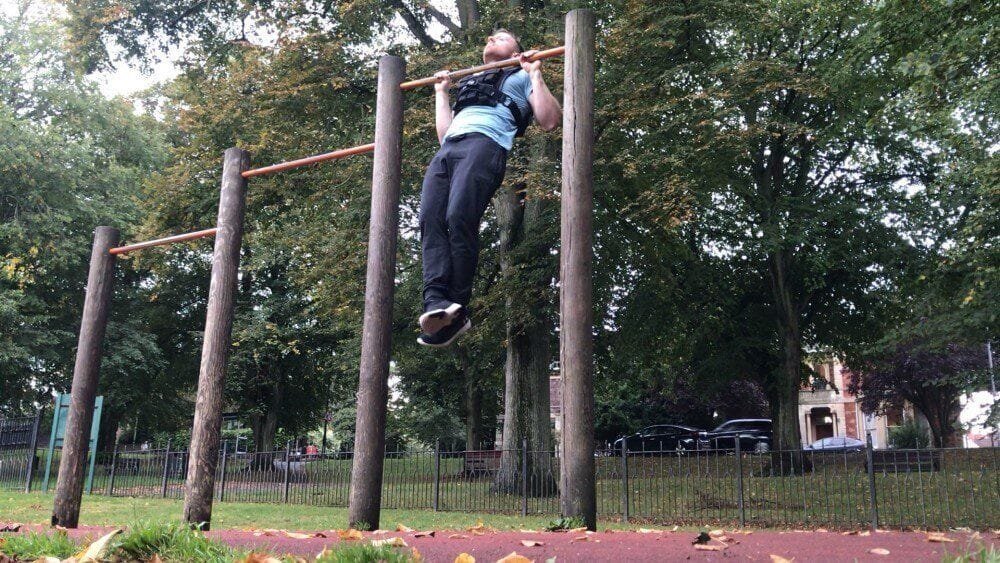It is not uncommon for pull-ups to be cited as the king of all upper-body exercises.
Almost every man and woman under the sun has wanted to increase the number of pull-ups they are able to perform at one point or another, and it is no wonder why.
Not only are pull-ups one of the best measures of overall strength there is out there, but they also happen to be one of the best exercises for building serious muscle.
Whether you are an absolute beginner to calisthenics or a seasoned veteran of the art, increasing the number of pull-ups you can do is always hugely beneficial.
In this article, we will be telling you about how you can increase the number of pull-ups you can perform as well as going over a few other factors that can affect your overall strength that you need to keep in check.
Create a Routine
Perhaps the most important step of all if you are looking to increase your pull-ups is to just create a simple yet effective routine.
Sure, if you have still yet to learn how to achieve your first pull-up then you may think that creating a routine is a little overkill. However, this is just not the case.
Even if you are struggling to complete your first pull-up, creating a schedule is going to exponentially help you achieve your goal, and you will be doing your first-ever full pull-up in no time.
Moreover, just to give one more tip for those of you who are yet to perform your first pull-up, there are a variety of things you can do to make the exercise easier like only focusing on the decline portion of the movement, putting a chair underneath you, and many others.
Now, to get on to the routine itself, creating a simple routine by having select days and specific times when you are going to perform pull-ups is essential. Furthermore, you also want to include a few rest days in between in order to give your muscles a chance to recover and grow.
For example, this is what a good beginner to advanced pull-up routine may look like;
- Monday: 5 sets of AMRAP (as many reps as possible)
- Tuesday: Rest
- Wednesday: 5 sets of AMRAP
- Thursday: Rest
- Friday: 5 sets of AMRAP
- Saturday: Rest
- Sunday: Rest
With this simplistic routine, you are guaranteed to see the number of pull-ups you can perform blow up, and in reality, this is something you will be able to do for a while before you need to think about making any changes at all.
Increase Reps & Add More Resistance

If you have been following a pull-up routine for a while and feel like your progress is coming to somewhat of a plateau, then it may be time to make a change.
If this sounds like you don’t worry. If anything, this just means you are on the right track.
At this point, it would be a good idea to introduce you to the concept of progressive overload – something which is an integral building block for improving strength and gaining muscle.
Progressive overload is a proven concept which states in order to build strength or muscle, you have to continuously cause more and more stress to your muscles.
In terms of pull-ups, this just means trying to get one extra rep in at the end of a set than you did the last workout, or perhaps try using a weighted vest to increase resistance.
Alternatively, you could also begin to incorporate the myriad of pull-up variations into your routine, which will not only increase the amount of resistance but also allow you to work on weak areas which might not be fully hit during the classic pull-up.
By using the multiple techniques we listed above, you will continue to make progress indefinitely with the pull-up, and you will be well on your way to becoming a master of the exercise.
It is important to note that you can’t expect to make consistent progress throughout your pull-up career. At first, progress will be ultra-fast, and you will more than likely be able to add extra reps every single week.
However, as time goes on, you will progress much slower, and by the time you are an advanced lifter, it may take weeks or even months to make any progress.
Hone in on Your Diet

Perhaps the most important yet most overlooked aspect when it comes to getting stronger on any exercise is perfecting one’s diet.
If you do not eat in a calorie surplus and get a good amount of protein in your diet, the rate at which you progress will be drastically hindered.
Luckily, altering your diet to be more focused on building muscle is not that hard of a task, and within just five minutes of research, you can have a good idea as to what your daily nutritional needs are.
In order to find out how many calories you should be eating every day to put on muscle, use a calorie calculator. From here, it will ask you to input all your data, and at the end, you will get your basic metabolic rate.
After this, add 250-500 calories on top of your maintenance, and you will have everything you need to bust through all your plateaus.
As for protein, as long as you try and get a few good sources of protein every day, you should be able to get more than enough in order to facilitate new muscle growth.
As long as you follow everything we stated in this section, your diet will not be a limiting factor in your training, and you will be able to continue making progress for years on end.
Work On the Specifics
If you are an advanced lifter who has been training for years, you may find it a little difficult to continue making progress by using the normal form of progressive overload.
Luckily, your journey doesn’t have to end here, and there are ways you can continue to improve upon the already impressive number of pull-ups you can do.
Working on specific areas of the pull-up can be of enormous benefit if you are looking to maximise the overall number you can do, and there are so many ways you can do this.
For example, improving your explosive pull-up strength by doing a program that focuses on the eccentric portion of the movement can help you hone in on the hardest section of the movement.
In turn, this will allow you to increase your explosiveness when going back to regular pull-ups, making you even stronger and giving you the potential to bang out an extra few more reps.
Another integral isolation skill you can learn that is vital to the pull-up is learning how to work on your grip strength. This is because, at a certain point, it is highly likely that your grip will give out way before your muscles.
So, as you’d expect, training your grip strength by doing specific isolation movements can help you increase your pull-up strength, or at least the very least, help you reach your maximum potential.
Advanced Tips
By this point, you will already be able to do more pull-ups than 90% of the population, and if you were expecting to be able to carry on making the same progress you did in those early years, you are going to be disappointed.
In reality, doing isolation movements will only make a drastic difference in the number of pull-ups you can perform if one or more of the areas you are focusing on are weak or a limiting factor in your pull-up strength.
That’s not to say you still cannot make progress – you certainly can.
However, it is important to have realistic expectations, and any strength improvements you see from this point on will be minuscule.
Just keep focusing on your training and keep achieving your goals, and remember to enjoy all the rewards that your endless years of hard work have given you.
We hope we have been able to give you a better idea of how you can increase the number of pull-ups you can do.
In reality, all the tools you need to do so are contained within this article, and if you are willing to put in the work, then you are guaranteed to succeed.
It can be disheartening if you are just beginning to do pull-ups and can only do a few at a time, or perhaps even none. However, don’t give up. Everyone was at this exact same stage at one point or another, and you will be surprised at just how fast you will progress in those vital early months.
Keep at it, and good luck.

Founder of www.calisthenics-101.co.uk. Training calisthenics since 2012.
Currently working on: 30 second one-arm handstand, muscle-up 360, straddle planche.
